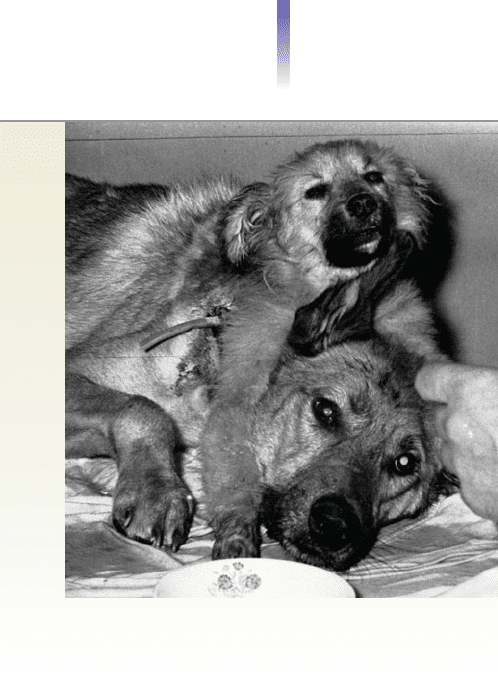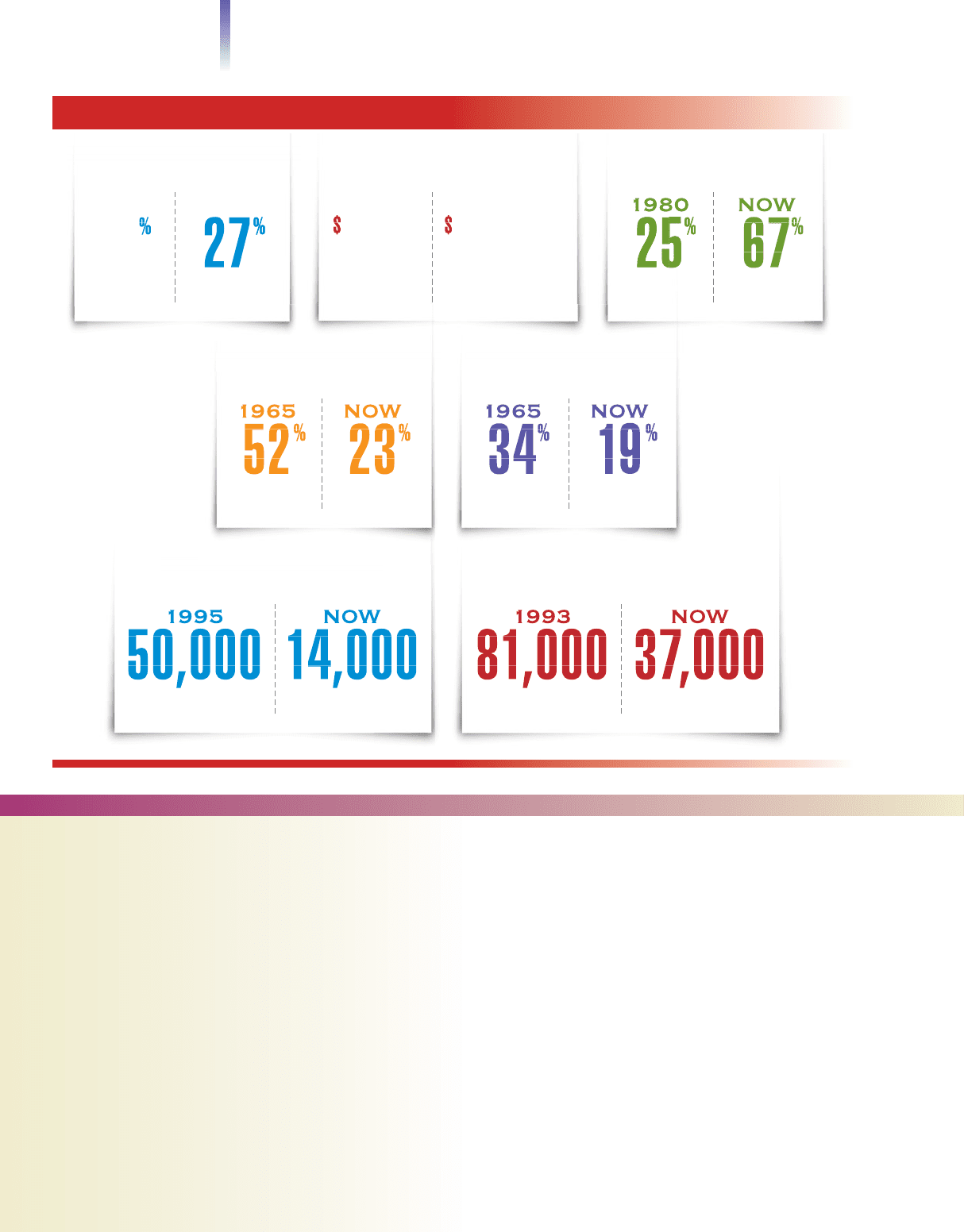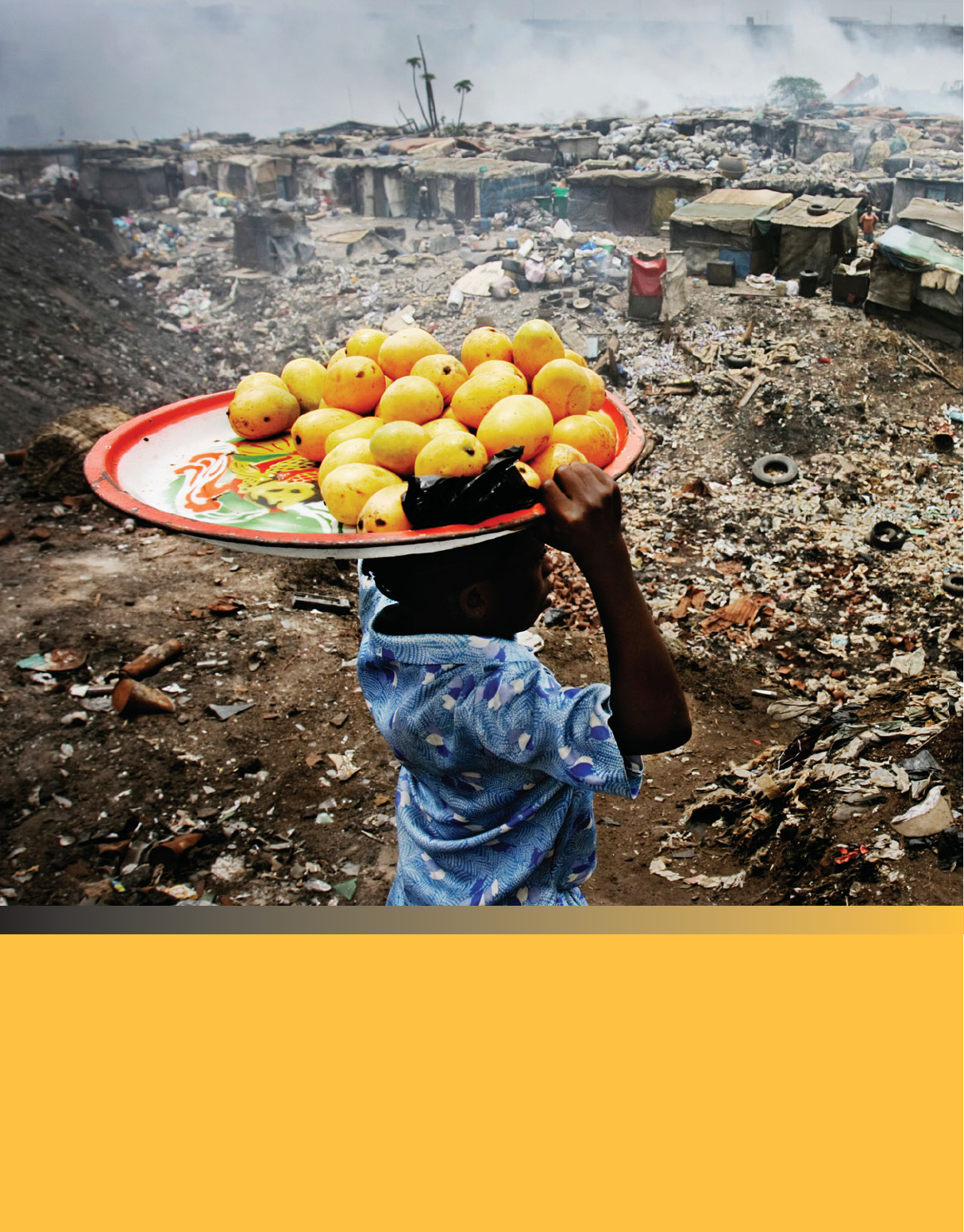Henslin James M. Sociology: A Down to Earth Approach
Подождите немного. Документ загружается.


Threats to Health 581
TABLE 19.1 What Drugs Have High School Seniors Used?
Source
:
By the author. Based on Johnston et al 2008a:Tables 2, 3.
In the past year?In the past month?
Alcohol 43.1% 66.5%
How many have been drunk? 27.6% 45.6%
Nicotine (cigarettes) 20.4% NA
Marijuana 19.4% 32.4%
Amphetamines 2.9% 6.8%
Barbiturates 2.8% 5.8%
Tranquilizers 2.6% 6.2%
Hallucinogens* 2.2% 5.0%
Cocaine 1.9% 4.4%
MDMA (Ecstasy) 1.8% 4.3%
LSD 1.1% 2.7%
Steroids 1.0% 1.5%
PCP 0.6% 1.1%
Heroin 0.5% 0.7%
*
Other than LSD.
Men MenWomen Women
In the past month? In the past year?
TABLE 19.2 What Drugs Have Full-Time College Students Used?
*
Other than LSD.
Alcohol 67.2% 66.2% 80.1% 81.4%
How many have 46.3% 47.1% 61.9% 66.7%
been drunk?
Nicotine (cigarettes) 21.8% 18.8% 32.2% 29.7%
Marijuana 20.2% 14.8% 35.8% 29.4%
Amphetamines 2.8% 3.2% 8.1% 6.2%
Hallucinogens* 2.2% 0.8% 7.3% 3.1%
Cocaine 1.8% 1.7% 6.3% 4.9%
Tranquilizers 1.6% 1.9% 1.3% 0.2%
Barbiturates 1.0% 1.6% 4.2% 3.2%
MDMA (Ecstasy) 0.5% 0.3% 1.4% 2.7%
LSD 0.7% 0.1% 2.2% 0.8%
Heroin 0.3% 0.1% 0.3% 0.1%
Source: By the author. Based on Johnston et al. 2008b:Tables 8-2, 8-3.
In Table 19.2, we turn to college students. Among them, too, alcohol is the most pop-
ular drug, and four out of five of all college students have drunk alcohol during the past
year, about two-thirds in the past month. About two of three have been drunk during the
past year, almost half in just the past month. As you can see, women are slightly more
likely to drink alcohol and to get drunk. In general, however, male college students are
slightly more likely to use drugs.
Is alcohol bad for health? This beverage cuts both ways. One to two drinks a day for
men and one drink a day for women reduces the risk of heart attacks, strokes, gallstones,
and diabetes (“Alcohol” 2009). (Women weigh less on average and produce fewer en-
zymes that metabolize alcohol.) Beyond these amounts, however, alcohol scars the liver,
damages the heart, and increases the risk of breast cancer. It also increases the likelihood
of birth defects. One-third of the 37,000 Americans who die each year in vehicle accidents
are drunk (Statistical Abstract 2011:Table 1109). Each year, 700,000 Americans seek treat-
ment for alcohol problems (Statistical Abstract 2011:Table 202).

Nicotine.
Let’s suppose that you are on your way to the airport to leave for a long-awaited vacation. You
are listening to the radio and thinking about the palm trees and ocean waves of sunny Hawaii.
Suddenly, an announcer breaks into your reverie with a flash bulletin: Terrorists have hidden
bombs aboard five jumbo jets scheduled for takeoff today. The announcer pauses, then adds:
“The authorities have not been able to find the bombs. Because they don’t know which flights
will crash, all flights will depart on schedule.”
Five jets are going to crash. On each jet will be 200 passengers and crew. They will plum-
met from the skies, leaving a trail of agonizing screams as they meet their fiery destiny.
What would you do? My guess is that you would turn your car around and go home.
Adios to Hawaii’s beaches, and hello to your own backyard.
Nicotine use—with its creeping side-effects of emphysema and several types of can-
cer—kills about 400,000 Americans each year (Centers for Disease Control and Preven-
tion 2009b). This is the equivalent of five fully loaded, 200-passenger jets with full
crews crashing each and every day—leaving no survivors. Who in their right mind
would take the risk that their plane will not be among those that crash? Yet this is the
risk that smokers take.
Nicotine is, by far, the most lethal of all recreational drugs. Smoking causes cancer of the
bladder, cervix, esophagus, kidneys, larynx, lungs, and other body organs. Smokers are more
likely to have heart attacks and strokes, and even to come down with cataracts and pneumo-
nia (Surgeon General 2005). The list of health problems related to smoking goes on and on.
Then there is secondhand smoke, which is estimated to kill 50,000 nonsmokers a year
(Surgeon General 2006). This is the equivalent of another fully loaded jet going down
every two days.
An antismoking campaign that stresses tobacco’s health hazards has been so successful
that smoking is banned on public transportation and in most offices, restaurants, and, in
some states, even bars. Figure 19.11 shows how this antismoking message has hit home.
In four decades, cigarette smoking has been cut by more than half among U.S. men, and
almost that among U.S. women. As you look at this figure, you might be surprised to see
that most men used to smoke.
Millions of Americans wouldn’t think of flying if they knew that even one jet were
going to crash—yet they continue to smoke. Why? The two major reasons are addiction
and advertising. Nicotine may be as addictive as heroin (Tolchin 1988). While this may
sound far-fetched, consider Buerger’s disease:
In this disease, the blood vessels, especially those supplying the legs, become so constricted that
circulation is impaired whenever nicotine enters the bloodstream.
If a patient continues to smoke, gangrene may eventually set in. First a toe may have to
be amputated, then the foot at the ankle, then the leg at the knee, and ultimately at the hip.
. . . Patients are informed that if they will only stop smoking, it is virtually certain that the
otherwise inexorable march of gangrene up the legs will be curbed. Yet surgeons report that
some patients with Buerger’s disease vigorously puff away in their hospital beds following a
second or third amputation. (Brecher et al. 1972)
The second reason is advertising. Cigarette ads were banned from television in the
1980s, but cigarettes continue to be advertised in newspapers and magazines and on
billboards. Cigarette companies spend huge amounts to encourage Americans to
smoke—about $13 billion a year. This comes to $43 for every man, woman, and child
in the entire country (Centers for Disease Control 2007b). Although the tobacco indus-
try denies it, they target youth, often by associating cigarette smoking with success, high
fashion, and independence. Despite these denials, Joe Camel, the industry’s most blatant
attempt to lure children to smoke, has been banned. (See the photo on the next page.)
With fewer smokers in the United States, the tobacco companies have turned to recruit-
ing victims in the least industrialized nations. Their efforts to increase nicotine addiction
there have been quite successful, making nicotine deaths a serious problem in countries
such as China (Gu et al. 2009).
582 Chapter 19 MEDICINE AND HEALTH
1965
1985
2008
Percentage
10%
20%
30%
50%
40%
60%
Women
Men
Year
0
52
34
33
28
23
19
FIGURE 19.11 Who
Is Still Smoking?
The Percentage of
Americans Age 18 and
Over Who Smoke
Cigarettes
Source: By the author. Based on
Statistical Abstract of the United
States 2011:Table 200, and earlier
years.

Disabling Environments
A disabling environment is one that is harmful to people’s health. The
health risk of some occupations is evident: Lumberjacking, riding rodeo
bulls, and training lions are obvious examples. In many occupations,
however, people become aware of the risk only years after they worked
at jobs that they thought were safe. For example, during and after World
War II, several million people worked with asbestos. The federal govern-
ment estimates that one-quarter of them will die of cancer from having
breathed asbestos particles. It is likely that many other substances also
cause slowly developing cancers—including, ironically, some asbestos
substitutes (Meier 1987; Hawkes 2001).
Industrialization increased the world’s standard of living and brought
better health to hundreds of millions of people. Ironically, industrializa-
tion also threatens to disable the basic environment of the human race,
posing what may be the greatest health hazard of all time. The burning
of carbon fuels has led to the greenhouse effect, a warming of the earth that
may change the globe’s climate, melt the polar ice caps, and flood the
earth’s coastal shores. The pollution of land, air, and water, especially
through nuclear waste, pesticides, herbicides, and other chemicals,
poses additional risks to life on our planet. We discuss these problems in
Chapter 22.
Medical Experiments: Callous and Harmful
At times, physicians and government officials behave so arrogantly that
they callously disregard people’s health. Harmful medical experiments,
though well-intentioned, are an excellent example. We can trace these ex-
periments to 1895, with an attempt to find a way to immunize people
against syphilis. In that year, Albert Neisser, a physician in Germany, in-
jected young prostitutes—one was just 10 years old—with syphilis. Many came down with
the disease (Proctor 1999). Let’s look at two notorious instances in the United States.
The Tuskegee Syphilis Experiment. To review this horrible experiment conducted by
the U.S. Public Health Service, read the opening vignette for Chapter 12 (page 329).
To summarize here, the U.S. Public Health Service did not tell 399 African American
men in Mississippi that they had syphilis. Doctors examined them once a year, record-
ing their symptoms, and letting the disease kill them.
The Cold War Experiments.
Assume that you are a soldier stationed in Nevada, and the U.S. Army orders your pla-
toon to march through an area in which an atomic bomb has just been detonated. Be-
cause you are a soldier, you obey. Nobody knows much about radiation, and you don’t
know that the army is using you as a guinea pig: It wants to see if you’ll be able to with-
stand the fallout—without any radiation equipment. Or suppose you are a patient at the
University of Rochester in 1946, and your doctor, whom you trust implicitly, says, “I
am going to give you something to help you.” You are pleased. But the injection, it turns
out, is uranium (Noah 1994). He and a team of other doctors are conducting an exper-
iment to find out how much uranium it will take to damage your kidneys. (U.S. Depart-
ment of Energy 1995)
Like the Tuskegee experiment, radiation experiments like these were conducted on unsuspect-
ing subjects simply because government officials wanted information. There were others, too.
Some soldiers were given LSD. And in Palmetto, Florida, officials released whooping cough
viruses into the air, killing a dozen children (Conahan 1994). In other tests, deadly chemical
and biological agents, such as sarin, were sprayed onto naval ships to see if they were vulner-
able. The sailors in these tests wore protective clothing, but were unaware that they had be-
come white mice (Shanker 2002). In 2003, Congress approved a bill to provide health care
for 5,842 soldiers harmed by these secret tests.
Threats to Health 583
Do you think that this magazine ad is designed to
make cigarettes appealing to male youth? Although
tobacco industry officials denied that they were
trying to entice youth to smoke, evidence such as
this ad is overwhelmingly against them. It took
pressure from the U.S. Congress to get R.J. Reynolds
Tobacco Company to stop its Joe Camel ads.
disabling environment an
environment that is harmful to
health

584 Chapter 19 MEDICINE AND HEALTH
The Department of Veterans Affairs never learned the lesson,
and they are still using veterans for testing drugs. But this time
they get permission—by offering $30 a month to down-and-out
veterans of Iraq and Afghanistan. When a drug turns out to have
serious side effects, they delay telling their guinea pig veterans (“VA
Testing . . .” 2008).
Playing God. To most of us, it is incredible that government of-
ficials and medical personnel would callously disregard human life,
but it happens. Those in official positions sometimes reach a point
where they think they can play God and determine who shall live
and who shall die. And, obviously, the most expendable citizens
are the poor and powerless. It is inconceivable that the doctors who
did the syphilis studies would have used wealthy and powerful subjects.
The elite are protected from such callous disregard of human rights
and life. The only way the poor can be protected against such abuse
of professional power is if we publicize each known instance of
abuse and insist on vigorous prosecution of those who plan, di-
rect, and carry out such experiments.
Do such things still happen? You can decide for yourself. Con-
sider how medical researchers developed fetal surgery. Surgeons
were intrigued with the idea of operating on unborn children. Not
only did such surgery hold the possibility of extending medical
knowledge but the pioneers would also get their names in presti-
gious medical journals and be applauded by their peers. Yet such
experimental surgery could cost lives. To reduce the risk, the re-
searchers first experimented on animals. Their next step in refining their skills was to op-
erate on pregnant Puerto Rican women. Now that the procedures are proven, the main
patients are the unborn of the white and affluent (Casper 1998). The steps taken in this
process expose an underlying assumption about the value of life—from animals to Puerto
Rican women to white women. It is almost as though the researchers viewed themselves
as climbing an evolutionary ladder.
The Globalization of Disease
The year was 1918. Men and women, seemingly healthy the day before, collapsed and were
soon dead. In the morning, men wheeled carts down the streets to pick up corpses that were
left on porches like last night’s trash. In a matter of months, a half million Americans died.
Worldwide, the death toll reached between 20 million and 40 million. (Phillips 1998)
What silent killer had so abruptly hit the United States and most of the world? Incredi-
bly, it was the flu. For some reason, still unknown, a particularly lethal variety of the com-
mon flu bug had suddenly appeared.
Medical researchers fear that something like this will happen again. If it does, today’s
global jet travel, unknown in 1918, may make the outbreak even more deadly. Global
travel has destroyed the natural frontiers that used to contain diseases. In a matter of
hours, today’s airline passengers can spread a disease around the world. The resulting
number of deaths could make the 1918 death toll seem puny by comparison.
Such are the fears. New diseases keep appearing on the world scene, and antibiotics
are ineffective against many of them. When the Ebola virus made its surprise appearance
in 1976, with its particularly hideous form of death, the only way it could be contained
was to isolate an entire region of Zaire (Olshansky et al. 1997). When SARS (Severe
Acute Respiratory Syndrome) appeared in 2003, the World Health Organization of the
United Nations called emergency meetings, as did the Centers for Disease Control in the
United States. The fear was that SARS would encircle the globe, killing millions of peo-
ple in a short time. Each person with SARS was isolated, and cities and regions were de-
clared off limits to visitors. The same thing has happened with outbreaks of Asian bird
flu (avian influenza) and the Marburg virus in Angola that causes death from fever, di-
This two-headed dog is the result of an experiment by
surgeons in Moscow. Do you think that grafting the puppy
onto the adult dog, intended to advance techniques for
transplanting human organs, is justified?

Treatment or Prevention? 585
Thinking CRITICALLY
How Will Your Lifestyle Affect Your Health?
Let’s contrast Utah (home of the Mormons, who disapprove of alcohol, tobacco, extramarital sex,
and even caffeine) with its adjacent state Nevada (home of a gambling industry that fosters rather
different values and lifestyles).Although these two states have similar levels of income, education,
urbanization, and medical care, Nevadans are more likely to die from cancer, car wrecks, heart at-
tacks, kidney disease, lung diseases, and strokes. (Statistical Abstract 2011:Table 121)
As you can tell from this example, your lifestyle is fundamentally important for your health.
Lifestyles can lead you down a road to disease and illness—or to health and wellness. Of
course, you know this. Our schools and the mass media publicize the message that healthy
living—exercising regularly, eating nutritious food, maintaining an optimal weight, not smok-
ing, avoiding alcohol abuse, and not having a lot of sexual partners—leads to better health
and a longer life. It doesn’t take much reading to know that fatty, low-fiber foods bring dis-
ease and that a diet rich in fruits and leafy, green vegetables stimulates health.Yet the mes-
sage of how greatly lifestyle affects health falls on many deaf ears.
Although millions of Americans exercise regularly and watch their diet and weight, mil-
lions more gorge on potato chips, cookies, and soft drinks during their mesmerized hours
of watching television and wielding joy sticks.A shorter life and the misery of sickness are
simply not on people’s minds while snacks, reruns, and video games beckon. Prevention re-
quires work, while illness requires only a doctor’s prescription.
Most doctors, too, are attuned to writing prescriptions for health problems instead of
focusing on preventive medicine and “wellness.” When patients see their doctor, they don’t
want to hear “Lose weight, exercise, and don’t forget to eat your vegetables.” Who wants to
pay for that? You can get that message from your mother free. Patients want to leave their
doctor’s office with the message,“You’ve got such-and such”—and a comforting prescrip-
tion in hand to cure such-and such. Frankly, doctors make money writing prescriptions for
sick people, and to get physicians to turn their focus to “wellness,” we will have to make
“wellness” profitable. Under our current fee-for-service system, if doctors and hospitals
prevent illness, they lose money. Perhaps, then as some have suggested, we can pay doctors
and hospitals a fee for keeping people well.“Wellness” programs can be profitable. Many
companies have found that their medical bills are lower if they help their employees stay
healthy so they don’t become patients (Conlin 2007).
For Your Consideration
First, place the focus on yourself. How can you apply this information to live a healthier life?
Second, consider the broader picture, comprehensive “wellness” and prevention. How can
we improve disabling environments, decrease the use of harmful drugs, and stop businesses
arrhea, vomiting, and bleeding (LaFraniere 2005). Officials are also fearful of a power-
ful new form of tuberculosis that appeared in South Africa (Wines 2007; Dugger 2008).
When such deadly diseases—for which there is no cure—break out, world health of-
ficials send out emergency medical teams to seal off the area. They have been successful
in containing these diseases so far, but they fear that they won’t always be so fortunate.
Treatment or Prevention?
Let’s turn our attention again to the U.S. medical system. One promising alternative to
the way U.S. medicine is usually practiced is to change the focus from the treatment of
disease to its prevention. Let’s consider this in the following Thinking Critically section.

586 Chapter 19 MEDICINE AND HEALTH
from spewing industrial wastes into the air and using our rivers and oceans as industrial sew-
ers? How can we eliminate ads designed to seduce youth to use deadly drugs? How about
ads designed to get adults to tell their doctors what drugs they want? Finally, since we live in
a global village, how can we establish international controls and cooperation so we can cre-
ate a global health-producing environment?
The Future of Medicine
What will the practice of medicine be like in the future? You can expect current issues to
remain, such as the financing of health care, the extent it should be an individual or
governmental responsibility. Other issues mentioned in this chapter will also remain, such
as social inequality, malpractice lawsuits, and depersonalization. Some, such as conflicts
of interest and incompetence, will scandalize the medical profession. New diseases will
also appear, for which we will have to find new treatments. Beyond such carryover issues,
two trends seem to be shaping the future of medicine, alternative medicine and technology.
Alternative Medicine
It is likely that despite attempts of the American Medical Association to enforce a con-
forming view of illness and health, competing views and practices will demand equal time.
An example is alternative medicine, also called nontraditional medicine. This term often
refers to medical practices imported from Asian cultures. From the perspective of tradi-
tional Western medical theory and practice, most alternative medicine makes no sense. Re-
garding it as the superstitious practices of ignorant people, Western doctors usually turn
a scornful and hostile eye at alternative medicine. They first ridiculed acupuncture, for ex-
ample, because it violated their understanding of how the body works. But with patients
reporting results such as pain relief, acupuncture has slowly been accepted in U.S. med-
ical practice.
Many U.S. patients have begun to demand alternatives, and the U.S. medical establish-
ment has started to listen. Although the change is slow, in some places the Western and East-
ern approaches to medical care are being combined. In two hospitals in Savannah, Georgia,
standard and alternative doctors work alongside one another. Patients are given traditional
treatment accompanied by yoga, meditation, and shirodhara, in which warm herbalized
sesame oil is slowly dripped onto the patient’s forehead. Patients may also choose polarity
therapy (to unblock energy), biofeedback, Chi-
nese face-lifting, and aromatherapy (Abelson and
Brown 2002). Hospitals affiliated with Stanford
University, the University of Maryland School of
Medicine, and Harvard Medical School have also
begun to offer a touch of alternative medicine
(Keates 2003; Waldholz 2003).
The change is just a trickle at this point, but
what is sociologically significant is that alterna-
tive medicine has begun to make inroads into
the exclusive club run by the U.S. medical es-
tablishment.
Technology
Technology is certainly destined to have pro-
found effects on medicine. Let’s close this chap-
ter with a look at just one aspect of these coming
changes, one that, with a strange twist, will
bring medicine closer to its roots, that of doctors
making house calls.
Using leeches, an old medical treatment, is making a come-back. Researchers have
found that the chemicals the leeches inject when they bite relieve symptoms of
arthritis and other conditions.
alternative medicine (also
called nontraditional medicine)
medical treatment other than
that of standard Western med-
icine; often refers to practices
that originate in Asia, but may
also refer to taking vitamins not
prescribed by a doctor

The Future of Medicine 587
SOCIOLOGY and the
NEW TECHNOLOGY
Making Virtual House Calls: Visiting
Your Doctor Online
No more taking time off of work, filling out
lengthy paperwork or spending hours to visit your
local Doctors office. Just visit one of our online
doctors today were available 24/7. Sign up and a
Doctor or Nurse will be with you in minutes.
—Quoted from an online medical site
(whose quality of English may or may not
be indicative of its doctors’ practice of medicine)
U.S. medicine is finally moving into the digital age. In
some places, you can log online and have a face-to-face
consultation (via Webcam) with your doctor. Not only
can you describe your symptoms, but you can also use
your computer camera to show you doctor what hurts.
After looking, listening, and asking questions—the
usual thing—the physician gives advice and writes a
prescription.The physician files the prescription with
your local pharmacy, which will deliver it to your door.
Great for rural areas, where there is a shortage of
physicians. And also great for people who want to
avoid traffic jams, germ-infested doctors’ offices, and,
of course, those outdated magazines.
Meg Young was running a 102-degree fever when
she arrived in Boston. She considered going to a
hospital emergency room, but instead she went to
her hotel room. There she went online and hooked
up with her primary doctor in California. After she
described her symptoms, he said she had a bacterial
infection. He prescribed an antibiotic, which she
picked up from a drugstore near her hotel.
“I couldn’t have been happier to not sit up in
some hospital half the night,” she said.
It is easy to see why some patients find virtual
house calls appealing. They also hold high appeal for
some doctors.
If you are an online physician, just like your patient
you don’t have to fight traffic. You don’t even have the
expense of running an office, paying nurses and utili-
ties. On top of this, you don’t even have to see pa-
tients in person. To avoid contact with all of those
germs is a nice side benefit. You get to sit at your
computer, talk to your patient, view some part of their
body, and write a prescription. This process also cuts
down on the boring chit-chat. And getting paid is no
problem. Patients don’t get to “see” you until after
their credit card has been approved.
Seeing the profit opportunity in this developing new
medical “specialty” of “online medical expert,” entre-
preneurs have already started to move in. Some com-
panies will arrange the online visits, maintain records,
and handle credit cards and insurance reimbursements.
Having a physician just a click away, around the
clock, seven days a week is just the beginning. Eventu-
ally, the virtual house calls will be made from mobile
phone to mobile phone. Talk about a time saver. Snap
an image of what hurts, and you will be able to visit
your doctor while you are driving your car.
Of course, if you get too involved in the house call,
after a crunching noise, you might be using your cam-
era phone to show more injuries than you intended.
Based on Costello 2008; Miller 2009; Song 2009.
For Your Consideration
Which would you prefer—visiting your doctor online
or in his or her office? Why? Do you think that virtual
house calls are the wave of the future or an experiment
that will disappoint and be discarded?
Well, not quite, but coming soon in some
form. Already, doctors can perform surgery on
patients who are in distant locations, even
thousands of miles away. Telesurgery is
performed through a combination of robotics
and live imaging.

New HIV/AIDS cases in a year
1993 NOW
Number of AIDS-related
deaths, per year, United States
1995 NOW
Americans who
are obese
NOW
%
Percentage of U.S. deaths
caused by heart disease
19 0 0
8
NOW
27
%
mber of AIDS related
U.
S
. death
s
a
rt d
i
sease
N
O
W
Men age 18 and over who
smoke, United States
1965 NOW
%%
A
me
r
a
r
e
Women age 18 and over
who smoke, United States
1965 NOW
%%
s
18
a
n
d
o
v
e
r
w
h
o
o
1
8
W
o
m
e
n
a
g
e
18
8
Annual cost of medical care
to the average American
1970
450
NOW
7,000
$$
588 Chapter 19 MEDICINE AND HEALTH
SUMMARY and REVIEW
Sociology and the Study of Medicine
and Health
What is the role of sociology in the study of medicine?
Sociologists study medicine as a social institution. As
practiced in the United States, three of its primary char-
acteristics are professionalization, bureaucracy, and the
profit motive. P. 558.
The Symbolic Interactionist Perspective
What is the symbolic interactionist perspective on
health and illness?
Health is not only a biological matter but is also intimately
related to society. Illness is also far from an objective con-
dition, for illness is always viewed from the framework of
culture. The definitions applied to physical and mental
conditions vary from one group to another. Pp. 558–559.
The Functionalist Perspective
What is the functionalist perspective on health
and illness?
Functionalists stress that in return for being excused from
their usual activities, people have to accept the sick role.
They must assume responsibility for seeking competent
medical help and cooperate in getting well so they can
quickly resume normal activities. Pp. 559–560.
The Conflict Perspective
What is the conflict perspective on health and illness?
Health care is one of the scarce resources for which groups
compete. In 1910, the education of physicians came
under the control of a group of men who eliminated most
of their competition and turned medicine into a monop-
oly that has become the largest business in the United
States. On a global level, health care follows the stratifica-
tion that we studied in Chapter 9. The best health care is
By the Numbers: Then and Now

available in the Most Industrialized Nations, the worst in
the Least Industrialized Nations. Pp. 560–565.
Historical Patterns of Health
How have health patterns changed over time?
Patterns of disease in the United States have changed so
extensively that of today’s top ten killers, four did not even
show up on the 1900 top ten list. Because most Americans
live longer than their ancestors did, we can conclude that
contemporary Americans are healthier. For mental illness,
we have no idea how the current rate of mental illness
compares with that of the past, for we have no baselines
from which to make comparisons. Pp. 565–566.
Issues in Health Care
How does treating health care as a commodity
lead to social inequalities?
Because health care is a commodity to be sold to the high-
est bidder, the United States has a two-tier system of med-
ical care in which the poor receive inferior health care for
both their mental and physical illnesses. Pp. 566–568.
What are some other problems in U.S. health care?
One problem is defensive medicine, which refers to medical
procedures that are done for the physician’s benefit, not for
the benefit of the patient. Intended to protect physicians
from lawsuits, these tests and consultations add huge
amounts to the nation’s medical bill. Other problems are
incompetence, depersonalization, conflict of interest, med-
ical fraud, and racism and sexism. Pp. 568–572.
What is the controversy over physicians helping
people end their lives?
People’s bodies can be kept alive by technology even when
they have no brain waves. This leads to questions about the
meaning of life and when to “pull the plug.” Doctors giv-
ing prescriptions to end life is also an issue, fueled by re-
search findings on euthanasia in Holland. Pp. 572–574.
What attempts have been made to cut medical costs?
Health maintenance organizations (HMOs) and diagno-
sis-related groups (DRGs) are among the measures that have
been taken to reduce medical costs. Proposals for national
health insurance have ended in controversy, but the most
controversial proposal is to ration medical care. Pp. 574–576.
Threats to Health
What are some threats to the health of Americans?
Threats to the health of Americans include AIDS, which
has stabilized in the United States but is devastating sub-
Saharan Africa; obesity and thinness; alcohol and nico-
tine; disabling environments; unethical experiments, of
which the Tuskegee syphilis experiments and the Cold
War radiation experiments are two examples; and the
globalization of disease. Pp. 576–586.
The Future of Medicine
What is the future of medicine?
Many present aspects of medicine will continue into the
future, but alternative medicine and technology are likely
to shape the future of medicine. Pp. 586–587.
THINKING CRITICALLY ABOUT Chapter 19
1. A major issue in this chapter is the tension between medi-
cine as a right and medicine as a commodity.What argu-
ments support each side of this issue?
2. How does lifestyle affect health? What does this have to do
with sociology?
3. Have you had an experience with alternative medicine? Or
do you know someone who has? If so, how did the treat-
ment (and the theory underlying the cause of the medical
problem) differ from standard medical practice?
Summary and Review 589
ADDITIONAL RESOURCES
What can you find in MySocLab? www.mysoclab.com
• Complete Ebook
• Practice Tests and Video and Audio activities
• Mapping and Data Analysis exercises
• Sociology in the News
• Classic Readings in Sociology
• Research and Writing advice
Where Can I Read More on This Topic?
Suggested readings for this chapter are listed at the back of this book.

Population
and Urbanization
20
Chapter
